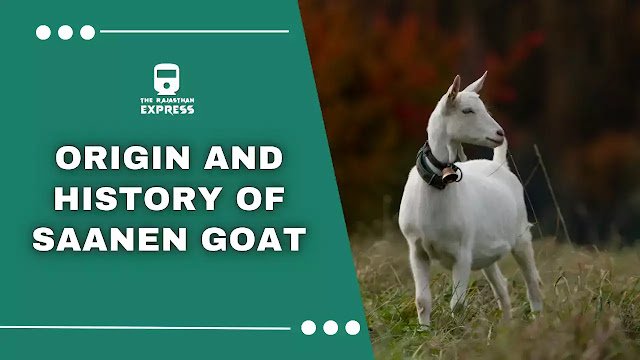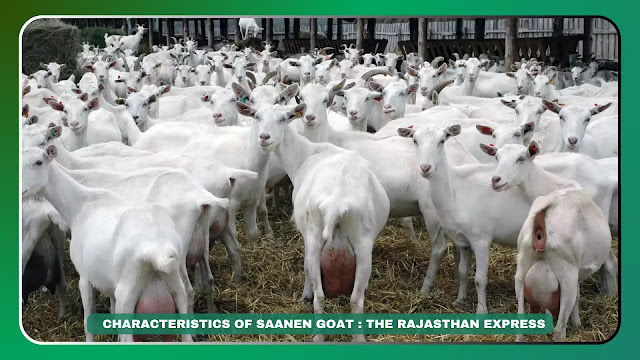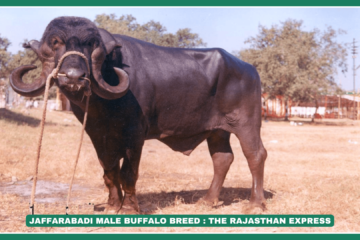Saanen Goat: Origin, History, Distribution, and Uses
The Saanen goat is a Swiss breed that originated in Switzerland. It is one of the prominent dairy breeds in Switzerland, primarily raised for milk and meat production. Saanen goats are medium-sized and white in color. They are considered the highest milk-producing breed of goats in the world, making them particularly popular for dairy production. This breed originates from the southern part of the Bern Canton in Switzerland, along the banks of the Saanen Valley River. Named after the river, the breed is known as the ‘Saanen goat.’ The Saanen River, also referred to as the Sarena, is a major river in Switzerland, stretching 128 km (80 miles) and covering an area of approximately 1,892 square km. It flows from near Sanetschhorn in the Valais Canton.
Another famous breed developed in the Bernese Oberland region of the Bern Canton is the Simmental cow. The Simmental cow originates from the valley of the Simme River, a tributary of the Kander River. The Simmental cow is a multi-purpose breed in Switzerland, raised for milk, meat production, and agricultural work.
The Bernese Oberland is a hilly area located within the Bern Canton of Switzerland. Thus, both regions of Switzerland—Saanen and Simmental—are renowned for their unique animal breeds, which significantly contribute to milk and meat production.
Saanen Goat Breed
| General Information |
|
|---|---|
| Common Name |
|
| Region of Origin |
|
| Primary Uses |
|
| Distribution | Worldwide, with significant populations in Australia, UK, and USA |
| Environmental Adaptation | Thrives in temperate climates but sensitive to extreme conditions |
| Coat Color |
|
| Average Male Height (cm) | 81 |
| Average Female Height (cm) | 76 |
| Average Male Weight (kg) | 65 – 77 |
| Average Female Weight (kg) | 61 – 65 |
| Milk Production Capacity | 4.29 kg per day |
| Lactation Duration (days) | 266 |
| The Rajasthan Express: Your Guide to Animal Health | |
Origin and History of Saanen Goat
The Saanen goat originated in the Saanen Valley and along the banks of the Saanen River in the southern part of the Bern Canton in Switzerland. The breed derives its name from its birthplace, Saanen Valley. Selective breeding of this breed has been practiced in Switzerland for many years, leading to its development.
The Saanen goat is the world’s highest milk-producing goat breed, primarily raised for milk production. This breed holds a significant place in the dairy industry. Saanen goat milk is particularly used for treating patients with platelet deficiencies, such as those suffering from dengue fever, where its milk is preferred.
Thus, the Saanen goat is viewed as a leading breed in the field of milk production.
Distribution of Saanen Goat
The Saanen goat is a well-known breed in Switzerland, primarily found around the Saanen Valley and the Saanen River in the southern areas of the Bern Canton. Due to its high milk production capacity, this breed is found not only in Europe but also on other continents.
In Australia, the Saanen goat is one of the most popular dairy goat breeds. It was among the first dairy goat breeds brought to Australia. In 1913, the New South Wales Department of Agriculture imported two males and ten females from Switzerland and France. Subsequently, two male goats were imported from Canada in 1929. Although the Nyngan farm closed in 1933, the Saanen goats brought there significantly contributed to the breed’s development in Australia. Australian Saanen goats have set several world records in milk production.
The history of Saanen goats in the United Kingdom began in 1922 when they were imported from Holland. These goats played a crucial role in the development of British breeds. Later, goats were imported from Switzerland in 1965, semen from Switzerland in 1993, and again goats from Holland in 1997/98. The British Goat Society (B.G.S.) has registered Saanen goats. According to a report by the B.G.S., the average milk production capacity of 205 Saanen goats participating in milk testing was found to be 4.29 kg (per 24 hours), with 3.58% fat and 2.66% protein. This outstanding capacity distinguishes the Saanen goat in the dairy industry from other breeds.
The Saanen goat was also imported to the United States from Switzerland, and it is one of the first goat breeds imported into North America.
Main Uses of Saanen Goat
The Saanen goat is a well-known breed in Switzerland and is considered one of the highest milk-producing goats in the world. It is primarily raised for milk production. A Saanen goat typically produces about 4 to 5 liters of milk per day, making this breed very popular in the dairy industry, where it is raised on a large scale.
Saanen Goat Characteristics
- Body: The Saanen goat is of medium size, with females weighing around 65 kg (143 lbs) and males ranging from 80 to 85 kg (176 to 187 lbs). Compared to other Alpine breeds, they have an average height and a generally calm demeanor. They are sensitive to cold and can struggle with intense sunlight.
- Face: The Saanen goat has a straight face with a slight slope, and its body is wedge-shaped.
- Color and Coat: Typically, Saanen goats are white or cream-colored, with soft skin and a white coat. They often have longer white hair on their hindquarters and genitals.
- Ears: Their ears are pointed and remain alert at all times.
- Udder: Saanen goats have well-developed, soft, and loose udders that do not appear muscular after milking. The udder is large and visually appealing.
- Horns: Saanen goats generally have horns, but they can be polled (hornless) as well. Horns may or may not be present at birth.
Size Specifications
- Saanen Female Goat (Nanny/Doe):
- Height: 30 inches (76 cm) (~2.5 feet)
- Weight: 61 – 65 kg (~134 – 143 lbs)
- Saanen Male Goat (Buck):
- Height: 32 inches (81 cm) (~2.66 feet)
- Weight: 65 – 77.27 kg (~143 – 170 lbs)
Saanen Goat Milk Production
The Saanen goat is recognized as the world’s leading milk-producing goat breed. According to a report from the British Goat Society:
- Average Daily Milk Production: 4.29 kg
- Fat Percentage in Milk: 3.58%
- Protein Percentage in Milk: 2.66%
- Average Milk Yield per Lactation: 800 – 850 kg
- Lactation Length: 266 days
This breed’s milk fat percentage is comparable to that of Holstein Friesian cow milk, making it highly valuable in dairy production.
Key Points
- Jamunapari Goat: Known as the heaviest, largest, longest, and most beautiful goat breed in India, and it also ranks among the highest milk-producing goats in the country.
- Saanen Goat: Considered the highest milk-producing goat breed globally.
- Gestation Period: The gestation period for goats is typically between 150 to 155 days.
Uncover the origins, characteristics, and milk production abilities of Saanen goats, one of the most valuable dairy breeds globally.
People Also Ask
How much milk does a Saanen goat produce?
What are the characteristics of Saanen goats?
- Color: Typically white or cream-colored.
- Size: The weight of a female goat is around 65 kilograms, while the male goat can weigh between 80 to 85 kilograms.
- Temperament: They are calm and tolerant but sensitive to cold and direct sunlight.
- Face: Straight with a slight tilt.
- Udder: Well-developed and soft, remaining muscular even after milking.






